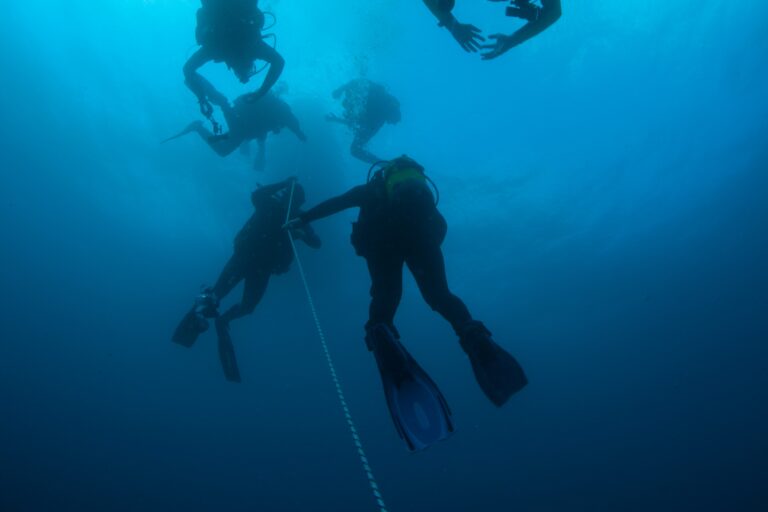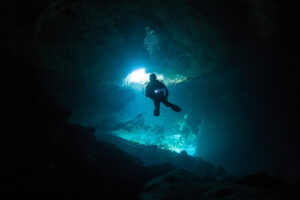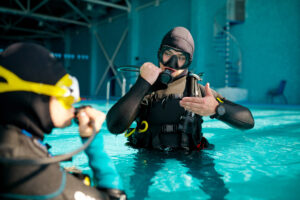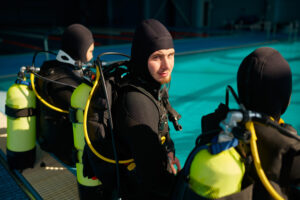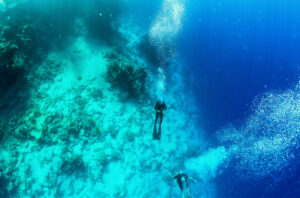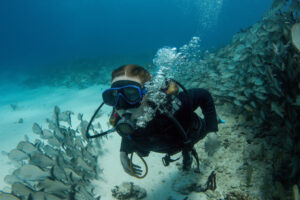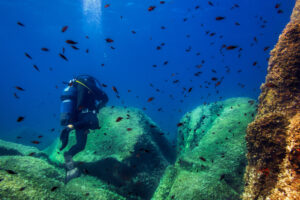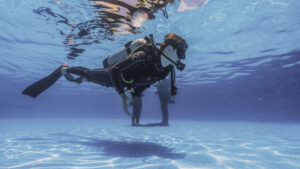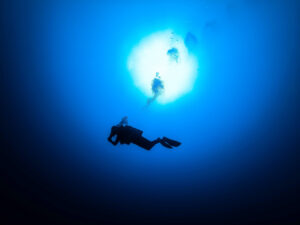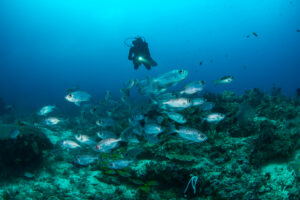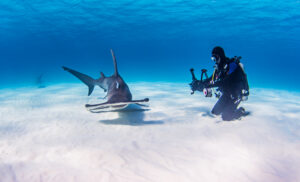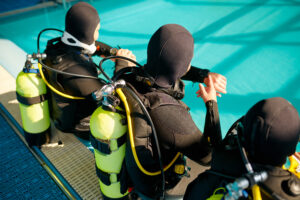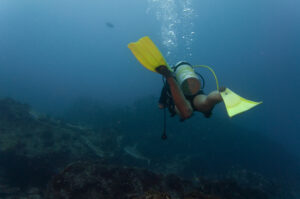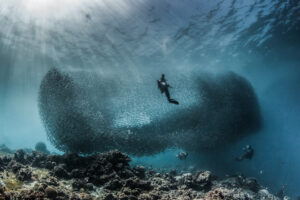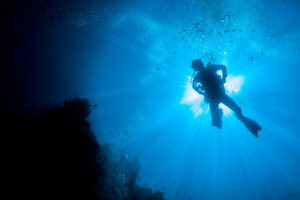What is a Decompression Stop in Scuba Diving?
A decompression stop is a critical part of the scuba diving ascent process. Decompression stops are designed to prevent the dangerous condition known as decompression sickness (DCS). This essential pause allows the body to safely eliminate dissolved gases, primarily nitrogen, from the bloodstream. Understanding the science behind decompression stops and their proper execution is vital for scuba divers to ensure a safe and enjoyable diving experience.
Physiological Basis
While scuba diving, the body’s physiology interacts in complex ways with the underwater environment, particularly concerning the absorption and release of gases. As divers inhale from their scuba gear, their bodies absorb the gases present in the breathing mix, typically composed of nitrogen and oxygen, with the balance of these gases shifting under the increased pressure of the water column above them. The deeper a diver goes, the greater the ambient pressure, resulting in the body’s tissues absorbing more nitrogen. This increased absorption is due to Henry’s Law, which states that the amount of gas that can be dissolved in a liquid (in this case, the body’s tissues) is directly proportional to the pressure of the gas above the liquid.
As the diver begins their ascent and the pressure gradually decreases, the body must expel the absorbed gases to maintain equilibrium and prevent potential harm. This is where the process becomes risky. If the diver ascends too quickly, the dissolved nitrogen may not have sufficient time to be released safely from the tissues. Instead, it forms bubbles within the body – a phenomenon akin to opening a pressurized soda bottle. This rapid formation of bubbles within tissues and the bloodstream can lead to a dangerous condition known as decompression sickness, making a slow and measured ascent vital for divers.
Decompression Sickness
Decompression sickness, colloquially known as “the bends,” is a serious condition that arises from improper decompression during a diver’s ascent. As nitrogen bubbles form in the body, they can create a range of symptoms, from mild to severe. In mild cases, a diver may experience joint and muscle pain, often described as a deep, dull ache – giving the condition its name, as sufferers often feel as if they need to bend their joints to alleviate discomfort. Skin rashes, fatigue, and dizziness can also occur, along with more severe symptoms like chest pain and difficulty breathing.
However, if the condition escalates, the consequences can be dire. Nitrogen bubbles can obstruct blood vessels, compromising circulation and potentially causing paralysis, or even death. If these bubbles travel to or form in vital organs, they can cause significant damage, leading to conditions such as arterial gas embolism. To prevent decompression sickness, divers are trained to make decompression stops during their ascent. These are periods where the diver pauses at specific depths to allow their body to safely expel the excess nitrogen absorbed at depth. The careful execution of these stops is critical in ensuring a safe dive, emphasizing the importance of proper training and adherence to dive safety protocols.
Decompression Stop Procedures
A decompression stop is a pre-planned pause during a diver’s ascent, typically at specific depths and for specific durations. The required stops and their durations depend on factors such as dive depth, dive duration, and the diver’s personal decompression algorithm or dive table. During a decompression stop, the diver remains at a constant depth, usually maintaining neutral buoyancy, to allow the body to eliminate dissolved nitrogen through respiration. There are two types of decompression stops:
Safety stop
A safety stop in the context of scuba diving refers to a voluntary pause that divers take towards the end of their dive, usually at a depth of approximately 5 meters or 15 feet, and lasting between 3 to 5 minutes. Although this practice is not strictly enforced by dive tables—standardized charts that dictate the maximum length of time divers can spend at certain depths—it is a highly recommended procedure that has been adopted widely within the diving community. The purpose of a safety stop is to further reduce the risk of decompression sickness, a potentially serious condition that can occur when divers ascend too quickly and dissolved gases in the body form bubbles. This extra time at a shallow depth allows the diver’s body to eliminate any residual nitrogen, particularly after dives that push the limits of no-decompression time.
Mandatory decompression stop
In contrast to a safety stop, a mandatory decompression stop is a compulsory pause that divers must take when they exceed the no-decompression limits—meaning they’ve stayed under the water at depth for a duration that necessitates a staged ascent—or when conducting technical dives that involve deeper depths and longer bottom times. The timing and depth of these stops are carefully calculated using decompression algorithms or dive tables to allow divers to safely off-gas, or eliminate, the nitrogen and other gases that have built up in their body tissues during the dive. These decompression stops are critical for preventing decompression sickness, a potentially life-threatening condition that can cause symptoms ranging from joint and muscle pain to neurological and pulmonary issues. Compliance with the mandatory decompression stop guidelines ensures that divers can surface safely, no matter the complexity of their dive.
Diving Modes and Decompression
Not all diving activities require decompression stops. Free-diving and snorkeling, where the diver only breathes gas at atmospheric pressure, typically do not necessitate decompression. Likewise, divers using an atmospheric diving suit (ADS) do not need to decompress, as the ADS maintains a constant internal pressure, preventing the absorption of excess nitrogen.
Decompression Planning and Equipment
Proper decompression planning is crucial for dive safety. Divers can use decompression tables, dive computers, or personal dive planning software to calculate their required decompression stops based on their dive profiles. Accurate monitoring of depth and time is essential during the dive, and divers should carry a backup timing device and depth gauge in case of equipment failure.
Modern dive computers provide real-time information on required decompression stops. Diver computers can adjust the recommendations based on the diver’s actual ascent rate, making them a valuable tool for dive safety. However, divers must understand their dive computers’ limitations and potential failure points and be prepared to follow a backup plan if needed.
The Importance of Decompression Stops during Dives
Decompression stops are vital to scuba diving safety, allowing the body to expel dissolved nitrogen and prevent decompression sickness. Divers must understand the physiological basis, proper execution , and planning involved in decompression stops to ensure a safe and enjoyable diving experience. By using appropriate decompression planning tools, such as dive tables, dive computers, or personal dive planning software, divers can calculate the necessary stops based on their specific dive profiles. Staying vigilant about depth and time monitoring, carrying backup equipment, and adhering to established decompression protocols are essential in mitigating the risk of decompression sickness.
Furthermore, it is crucial for divers to recognize the different types of decompression stops, such as safety stops and mandatory decompression stops, and to understand when they are necessary. Recognizing that not all diving activities require decompression stops, like free-diving, snorkeling, and diving with an atmospheric diving suit, can help divers choose the appropriate diving mode for their specific needs.
Education and training in decompression theory and practice are also vital for dive safety. Divers should seek reputable scuba diving courses and certifications that emphasize decompression knowledge and skills. Divers should also continue to update their training as new techniques and technologies emerge.
Decompression stops play a critical role in scuba diving safety by allowing the body to safely release dissolved gases, primarily nitrogen, and prevent decompression sickness. By understanding the science behind decompression stops, adhering to proper procedures, and using appropriate planning and monitoring tools, divers can enjoy the underwater world while minimizing the risk of decompression-related injuries.

